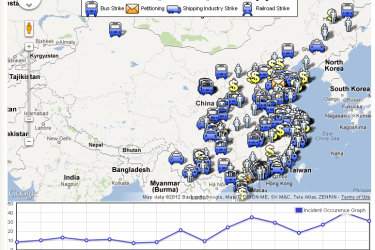Communist Party of China
On 8 May, around 1000 shoe factory workers in Dongguan walked out in protest at management plans to cut their monthly bonus from the usual 500 yuan to just 100 yuan. Management refused to talk so one worker posted their grievances on his micro-blog.
[For more discussion on China's economic and political development, click HERE.]
By Kevin Lin
March 11, 2012 -- Green Left Weekly/Links International Journal of Socialist Renewal -- Rural protests make up a large part of overall social unrest in China. But such protests had not received prominent international attention until the siege of Wukan, a village of 12,000 in Guangdong province, late last year.
Just like the strikes in Honda plants in 2010, Wukan brought to light the deep-seated grievances of villagers in a dramatic way. The revolt featured the eviction of party officials and the police, the self-management of the village by villagers, and the stand-off against armed police in a siege for more than a week.
The Wukan protest was triggered by the local government's land expropriation without adequate compensation to the affected villagers. It was escalated by the death of a protest leader in police custody.
The villagers showed remarkable courage in occupying their own village against predictable state repression.
By Doug Lorimer
[The general line of this report was adopted by the 18th DSP Congress, January 5-10, 1999. This text is taken from The Activist, volume 9, number 1, 1999.]
The purpose of this report is to motivate the adoption by the party of the "Theses on the Class Nature of the People's Republic of China" approved by the National Committee at its October plenum last year.
Since 1993 our party has held the position that the ruling Chinese bureaucracy has been presiding over the restoration of capitalism in China. However, our policy toward China has been ambigious: while taking an oppositional stance in our public press toward the ruling bureaucracy's restorationist course, we have left it unclear as to whether we continued to believe that China is still a bureaucratically ruled socialist state.
Strikes by workers are growing across China. Photo from KasamaProject.org.
[For more discussion on China's economic and political development, click HERE.]
By Kevin Lin
February 11, 2012 -- Green Left Weekly/Links International Journal of Socialist Renewal -- China’s transition to state-led capitalism over the past three decades has generated numerous social struggles against the state and capital. With China’s ascent in the capitalist world economy, the social struggles inside China not only have a significant domestic impact, but increasingly international ramifications.
As China celebrates the Year of the Dragon, it is an opportune time to critically review the situation for social struggles and their prospects for the future.
State and elite politics
[In English at http://links.org.au/node/2683.]
Por John Riddell
Workers at the Foxconn (the Taiwanese multinational corporation owned) factory located in China in which many Apple products are assembled.
[For more discussion on China's economic and political development, click HERE.]
By Martin Hart-Landsberg
January 24, 2012 -- Reports from the Economic Front, posted at Links International Journal of Socialist Renewal with the author's permission -- A January 22, 2012 New York Times story, "The iEconomy: How US Lost Out on iPhone Work", has been getting a lot of coverage. The article makes clear that Apple and other major multinational corporations have moved production to China not only to take advantage of low wages but also to exploit a labour environment that gives maximum flexibility.
The following quote gives a flavour for what attracts Apple to China:
[For more discussion on China's economic and political development, click HERE.]
By Wang Kan*, translated by Ralf Ruckus
Sozial Geschichte Online #6 (2011), posted at Links International Journal of Socialist Renewal with permission -- On May 17, 2010, a strike erupted at the Honda parts plant in Nanhai, a city located in the Chinese centre of the manufacturing industry in Guangdong province. More than 1800 workers participated, and the strike disrupted all of Honda’s spare parts production facilities in China and led to the paralysing of Honda’s car production in China. On May 28, the strike wave spread to a Hyundai carfactory and on May 29 to US-American Chrysler’s joint venture Jeep factory, both in Beijing. On June 18, Toyota’s second car plant in Tianjin had to close, due to a strike.
In July, the Chinese media were universally asked to restrict their coverage of the strikes, but the strikes in the auto industry still did not stop. Prior to July 22, at least two of Honda’s joint venture factories saw strikes. The organisers and most important participants of these strikes were migrant workers (nongmingong, peasant workers). During the strike wave they showed very strong collective consciousness and capacity for collective action.
